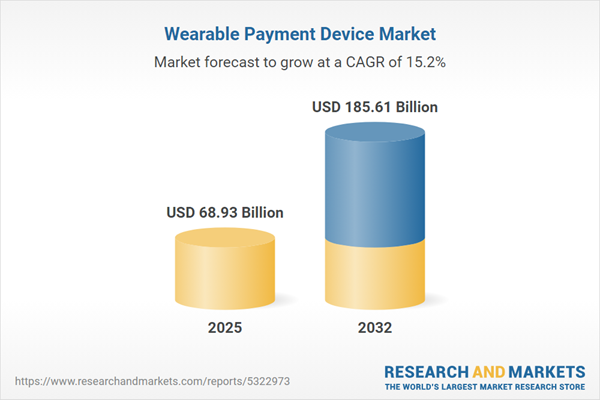Speak directly to the analyst to clarify any post sales queries you may have.
The wearable payment device market is undergoing rapid transformation as enterprises reimagine digital transaction methods. As business leaders navigate evolving compliance requirements, wearable payment technology emerges as an avenue for secure, flexible, and scalable financial operations within modern organizations.
Market Snapshot: Wearable Payment Device Market Size and Growth Projections
In 2024, the global wearable payment device market is valued at USD 59.90 billion, with expected growth to USD 68.93 billion in 2025 and forecasted expansion to USD 185.61 billion by 2032. This anticipated 15.18% CAGR is supported by strong enterprise demand for seamless digital financial solutions. Market momentum is driven by organizations aiming to achieve transaction efficiency and robust security while forming partnerships across technology domains. Device manufacturers, payment technology companies, and software providers are working together to accelerate adoption and deliver solutions meeting diverse regional needs.
Scope & Segmentation of the Wearable Payment Device Market
- Device Types: Smart apparel, rings, earwear, glasses, watches, and wristbands are facilitating streamlined digital transactions and increasing convenience in retail, enterprise, and service sectors.
- Payment Technologies: Solutions based on EMV chip, magnetic secure transmission, near-field communication, host card emulation, secure elements, and QR codes support integration, security, and flexibility for enterprises integrating wearable payments.
- End User Categories: Commercial enterprises, small businesses, and consumers are served, each requiring solutions for straightforward digital adoption, rapid onboarding, and protection of user privacy across platforms.
- Distribution Channels: Direct-to-consumer approaches, electronics retailers, specialist sellers, and online platforms are used to match varying business demands and customer preferences in multiple geographic locations.
- Geographical Coverage: Americas, Europe, the Middle East, Africa, and Asia-Pacific markets are addressed, with tailored adaptations to local regulatory requirements, infrastructure conditions, and payment cultures.
- Regional Analysis: Focus areas include the United States, Canada, Brazil, Mexico, Europe, the UAE, Saudi Arabia, Africa, China, India, Japan, and Australia, recognizing how regulation and payment behaviors inform product strategy and user experience.
- Companies Covered: Leading organizations such as Apple Inc., Samsung Electronics, Huawei, Xiaomi, Fitbit, Garmin, Fossil Group, OPPO, Huami, and Mobvoi are featured, each innovating and developing alliances to expand market influence.
Key Takeaways for Senior Decision-Makers
- Wearable payment devices are enabling organizations to secure digital transactions, streamline workflows, and deliver improved user experiences on a global scale.
- Collaborative industry partnerships are accelerating development of integrated platforms that support digital transformation while balancing comprehensive security needs for enterprise clients.
- Biometric authentication, advanced encryption, and privacy-by-design principles are at the forefront of security approaches adopted to build trust, particularly in highly regulated industries.
- Adoption of open standards allows organizations to adapt to evolving payment channels and simplifies international expansion within complex regulatory environments.
- Diverse channel strategies ensure alignment with varying regional requirements, enabling seamless access to both established and emerging markets.
- Multi-channel payment solutions are allowing organizations to adapt swiftly as customer and enterprise transaction preferences change across regions and industry sectors.
Tariff Impact and Supply Chain Agility
Changing tariff regulations in the United States are shaping how wearable payment device manufacturers manage their supply chains. Market leaders are addressing these influences by diversifying sourcing practices, increasing local assembly operations, and using modular design methods. This multi-faceted approach helps to minimize risk and strengthen resilience in the face of ongoing regulatory adjustments.
Methodology & Data Sources
This analysis is based on primary interviews with wearable device manufacturers and payment technology experts. Supplemental data comes from trusted trade sources, corporate financial reports, patent tracking, and verification of global product certifications, ensuring a rigorous and up-to-date market assessment.
Why This Report Matters: Strategic Benefits for Stakeholders
- Offers a comprehensive perspective on wearable payment device technology trends, partnership models, and adoption drivers, supporting leaders in developing informed market entry strategies.
- Clarifies region-specific regulatory requirements, assisting companies in effective deployment and long-term planning decisions.
- Provides actionable insights for maintaining competitive strength as enterprise models and customer payment demands continue to evolve across industries.
Conclusion
By prioritizing security and flexibility, organizations can confidently adjust to ongoing changes in the payment industry. Effective collaboration and proactive compliance with regional requirements will be central for sustained success in the wearable payment device market.
Additional Product Information:
- Purchase of this report includes 1 year online access with quarterly updates.
- This report can be updated on request. Please contact our Customer Experience team using the Ask a Question widget on our website.
Table of Contents
3. Executive Summary
4. Market Overview
7. Cumulative Impact of Artificial Intelligence 2025
List of Figures
Companies Mentioned
The companies profiled in this Wearable Payment Device market report include:- Apple Inc.
- Samsung Electronics Co., Ltd.
- Huawei Technologies Co., Ltd.
- Xiaomi Corporation
- Fitbit, Inc.
- Garmin Ltd.
- Fossil Group, Inc.
- OPPO Digital Inc.
- Huami Corporation
- Mobvoi Information Technology Company Limited
Table Information
| Report Attribute | Details |
|---|---|
| No. of Pages | 191 |
| Published | November 2025 |
| Forecast Period | 2025 - 2032 |
| Estimated Market Value ( USD | $ 68.93 Billion |
| Forecasted Market Value ( USD | $ 185.61 Billion |
| Compound Annual Growth Rate | 15.1% |
| Regions Covered | Global |
| No. of Companies Mentioned | 11 |









